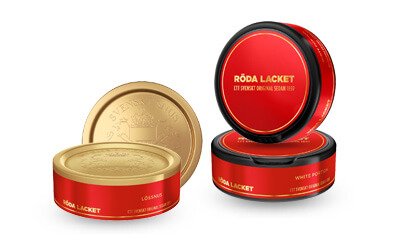Röda Lacket snus has delighted generations of Swedes since 1850. Its flavor profile boasts a wonderfully seductive aroma that’s smoky yet sweet, packaged in beautiful, easily recognizable red cans. Sticking to tradition, Röda Lacket provides loose snus with a fine grind, and it has nicotine contents of 7.5 mg/g.
An old story
The story behind Röda Lacket goes all the way back to the 18th century, when Petter Swartz founded a veritable snus empire in the pleasant Swedish town of Norrkoping. Besides possessing the born entrepreneur’s talent for making any business venture flourish, Swartz must have been a very discerning consumer of snus too, as the recipes he came up with quickly gathered a huge following all across Sweden. The company he founded was subsequently passed on to his equally brilliant descendants, who came up with this remarkable product in the mid 19th century. Needless to say, any consumer good that is still in existence after more than a hundred and fifty years has something going for it, and Röda Lacket is no exception. The smooth, sophisticated flavour, with just a hint of dried fruits and liquorice, certainly never gets old. Moreover, the taste continues to develop over time, which is definitely not true of some of its competitors.
Great consistency
For users of the loose version, one of the great things about Röda Lacket is how easy it is to mould the snus into a nicely shaped portion. Whereas some products will leave a terrible mess on your hands – bring me an apron, mummy! – baking a loose portion of Röda Lacket is both fun and undemanding, bringing to mind the experience of playing with clay as a child. This stuff doesn't stick to your fingers, and even a hastily baked portion keeps its solidity after an hour or so under your lip. The fact that customers can now also opt for a portion version has only consolidated Röda Lacket position as one of the classics in the world of snus. Much like other old companies with tried and tested recipes – Coca Cola comes to mind – Röda Lacket owes its success to never falling for the temptation to tamper with the formula that brought it success in the first place. We therefore shouldn’t be too surprised if it's still around by the turn of the next century.
Read moreLess 
 In English
In English 


